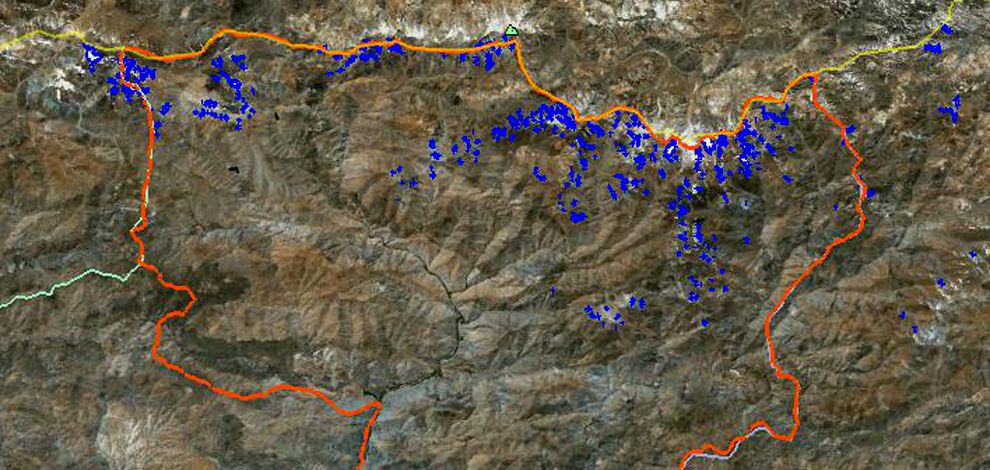Esta entrada también está disponible en: Spanish
Report reveals more than 400 glaciers at risk due to Barrick Gold’s Pascua Lama and Goldcorp’s El Morro projects in Diaguita-Huascoaltino Indigenous Territory
December 12 – Huasco Valley, Chille.
There are more than 400 glaciers in the indigenous territory belonging to the Diaguita-Huascoaltino peoples at risk due to mining at Pascua Lama (Barrick Gold) and El Morro (Goldcorp), according to a report published today by the Center for Human Rights and Environment (CEDHA).
The report includes the first ever full inventory of glaciers inside the autonomous Diaguita-Huascoaltino territory, and indigenous that recuperated land rights over their ancestral territory in what is now Chile. Many of these glaciers, according to CEDHA’s report, are directly in the impact areas of the two mega mining projects, seeking to extract gold, silver and copper from the ecologically sensitive high-mountain highlands spannign the border between Argentina and Chile. The glaciers are visible in publicily available programs like Google Earth or Google Maps, and can be seen simply by downloading CEDHA’s glacier inventory. In addition to their own mapping of the glaciers, CEDHA also consulted several partial inventories of the glaciers that had been commissioned by mining companies and another unfinished inventory underway by the Chilean government. Several annonymous sources concerned with the advance of mining operations in glacier territory along the Andes mountains (including the Pascua Lama and El Morro projects), also contrbuted to CEDHA’s work.
While both Goldcorp and Barrick Gold downplay the relevance of their activity on glaciers and periglacial environments, and only refer to a handful of glaciers in the area, CEDHA inventoried at least 118 uncovered white glaciers (glaciers with visible ice) on indigenous lands, all at risk from mining operations that elevate dust into the atmosphere which deposits on glacier ice, darkening it and thereby changing the glacier’s albedo (solar reflection) and thus accelerating glacier melt. In addition to the 118 uncovered glaciers, an additional 305 “covered” and/or “rock glaciers” are also present. These are glaciers that are covered or mixed with fine rock debris, and which would not be identifiable by an untrained eye, but which are definitely visible through satellite imagery if one knows what to look for. The glaciers are all between 3,600 and 5,800 meters above sea level.
The most revealing and alarming piece of the report is evidence of what is happening to glaciers near Pascua Lama, Barrick’s Gold project which is slated to be the world’s first binational mining projects. Three glaciers at the future mining pit site are already completely covered with contamination from the preparatory activity for Pascua Lama, and the project has not even begun to extract minerals (see photo). Glacier impacts have proven to be one of Barrick’s biggest problems at Pascua Lama, which has led among other things to the recent passage of a National Glacier Protection Law, which bans mining in glacier areas. The new law seriously undermines Barrick Gold’s operations at Pascua Lama, and the new evidence that is mounting againt the project confirms environmental organization claims that Barrick Gold is destroying glaciers.
CEDHA’s report reproduces images published by a technical team at Chile’s Centro de Estudios Científicos (CECs), that is monitoring glaciers at the mining site. Chile’s local community groups raised concern over Barrick’s initial plans to destroy three glaciers that rested on gold reserves, the Toro 1, Toro 2, and Esperanza glaciers. Barrick Gold released an incredible plan to “dynamite” and “bulldoze” the glaciers and then haul them off in dump trucks so the glaciers would not place their workers at risk when they extracted the gold beneath the ice. These glaciers now are practically invisible as they already lie beneath a thick mantle of contamination from road work around the mining site.
CEDHA, one of the main proponents of a national glacier protection law in Argentina, began inventorying glaciers near mining operations as soon as the law was passed in 2010. After publishing several reports on other mining activity in Argentina the Filo Colorado and El Pachón projects (Xstrata Copper), at Los Azules (McEwen Mining) and several others, the Diaguita-Huascoaltino Indigenous Community contacted the environmental group requesting that they do a glacier inventory and mining impact risks to these glaciers for the indigenous territory.
Chile does not have a glacier protection law, but it was the first country to submit one to Congress in the mid 2000s, based on the public outcry over the Pascua Lama project. CEDHA’s report is an easy instructional document aimed at teaching non-glacier experts how to recognize glaciers and periglacial environments (frozen grounds that act as water basin regulators). It’s part of an initiative CEDHA calls Democratizing Glaciers.
For more information contact:
+54 9 351 507 8376
Links to the report:
Link to the Glacier Inventory (for viewing in Google Earth):
https://center-hre.org/wp-content/uploads/2012/12/Glaciares-Huascoaltinos-Google-Earth-Polygons.rar
More information on CEDHA’s Mining and Glaciers works:

